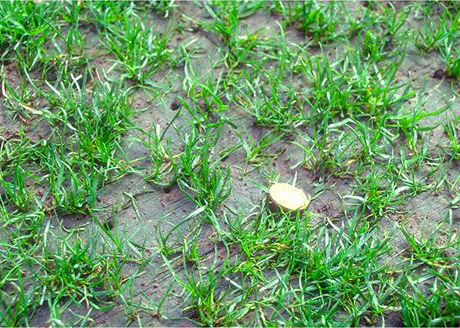Integrated Pest Management
Cyanobacteria / "Blue-green Algae"

Symptoms of cyanobacteria (Phil Colbaugh, Turfgrass Photo Diagnostics, Turfgrass-photodiagnostics.com)
Hosts, Symptoms & Signs
- black layer on thatch or thinned grass
- problem in areas that are heavily shaded, have poor drainage and high levels of phosphorus
- in large numbers, they move up on grass blades or cover the ground
- release of toxins causes grass to turn yellow and sometimes die
Disease Cycle
- blue-green algae are not algae, but are classified as cyanobacteria
- cyanobacteria can survive in habitats from aquatic to desert environments, including irrigated turfgrass
- cyanobacteria is most frequently found in wet, compacted, poorly drained, thin turf areas in shade, but may be found under drier conditions
- conditions that encourage cyanobacteria growth in turfgrass include warm temperatures, light that reaches the soil, excess moisture, soil layering, excess nitrogen and phosphorus
IPM Recommendations
- Minimize shade and excessive moisture.
- Aerate compacted/layered areas.
- Increase height of cut.
- Avoid phosphorus-containing fertilizers.
- Apply a fungicide (Chlorothalonil) three times at 7 day intervals.
Note: QoI (Quinone outside inhibitor) fungicides such as Heritage and Insignia could make the problem worse.


